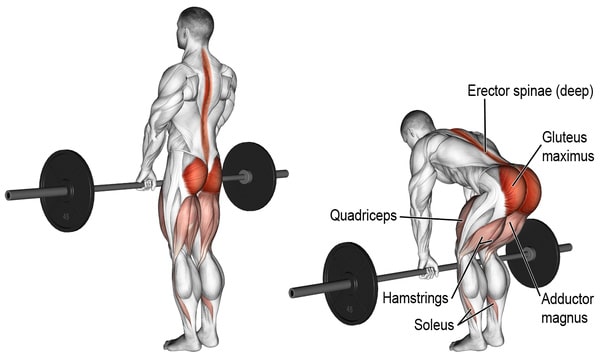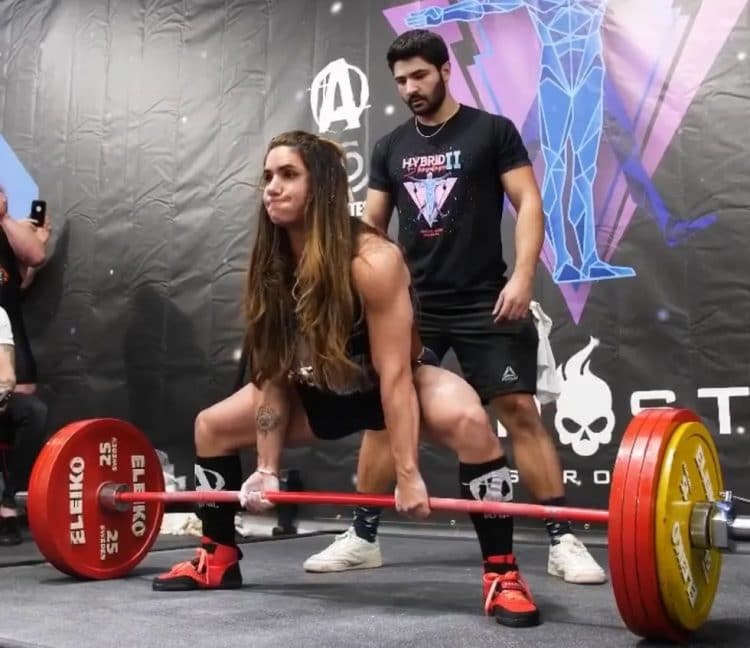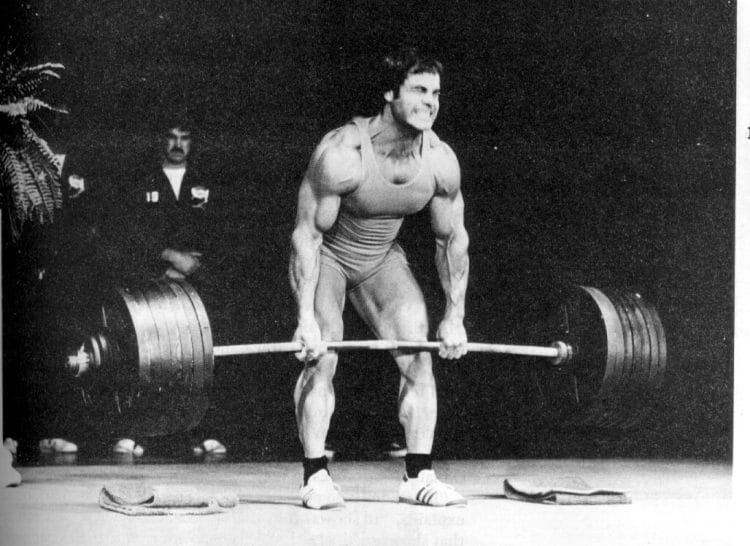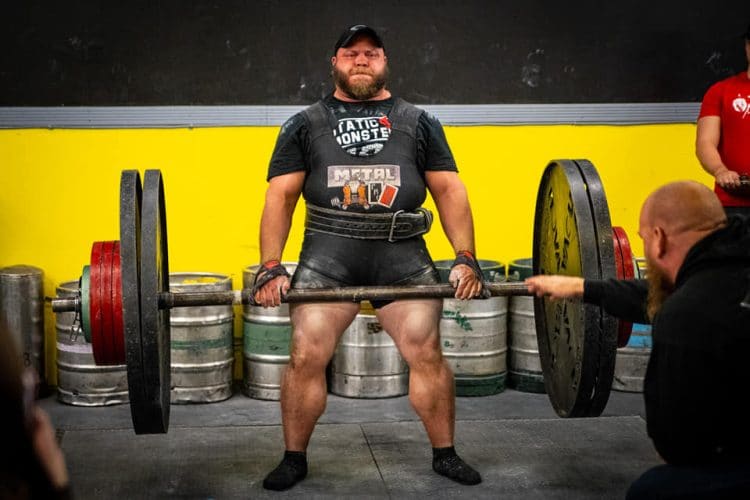Deadlifts are one of the most productive strength training exercises around. Not only are they the third discipline in powerlifting competitions, but deadlifts also teach you how to safely lift heavy objects off the ground, i.e., using your legs and back and without rounding your lumbar spine. Deadlifts also often feature in strongman events.
And it’s not just powerlifters and strongman competitors that love deadlifts – they’re a big hit with bodybuilders, too. If you want a bigger back, glutes, traps, and hamstrings, deadlifts are hard to beat.
Deadlifts are typically done using a stiff bar or deadlift bar, and you can also do them using a hex or trap bar. However, that’s not always the case. In some instances, the bar of choice for deadlifts is the so-called axle bar. That’s especially true for some strongman competitions.
So, which bar should YOU use for deadlifts?
In this article, we compare axle and barbell deadlifts so you can determine which one is right for you.
Deadlift Anatomy 101

Before we get into the differences between the axle and barbell deadlift, it’s important to understand that, in terms of the muscles involved, these two exercises are very similar. The movements are almost exactly the same, which means they involve virtually the same muscles.
Deadlifts are a compound exercise which means they use multiple joints and muscles working together. In fact, deadlifts are pretty much a full-body exercise. It’s actually quite hard to think of many muscles NOT involved in deadlift! That said, these are the muscles doing most of the work during axle and barbell deadlifts.
Hamstrings – located on the back of your thighs, the hamstrings are responsible for knee flexion and hip extension. The three hamstring muscles are the biceps femoris, semimembranosus, and semitendinosus.
Gluteus maximus – known as the glutes for short, this is the largest muscle in the human body. It’s responsible for the extension of the hips. The glutes are basically your butt.
Quadriceps – located on the front of your thighs, the quadriceps are responsible for extending your knees. The four quadriceps muscles are the rectus femoris, vastus lateralis, vastus medialis, and vastus intermedius.
Erector spinae – these are the muscles of your lower back. During deadlifts, the erector spinae muscles work to prevent your lumbar spine from rounding.
Core – this is the collective term for the muscles of your midsection. The main core muscles are the rectus abdominis, obliques, transverse abdominus, pelvic floor, and diaphragm. These muscles contract inward to compress your abdominal contents and increase intra-abdominal pressure, or IAP for short. IAP stabilizes and supports your lumbar spine from within.
Latissimus dorsi – known as the lats for short, these muscles are located on the side of your upper back. During deadlifts, your lats help keep the bar close to your legs and prevent it from swinging out and away. Strong lats are critical for successful deadlifting.
Trapezius – located across your upper back, the traps stabilize your shoulder girdle during deadlifts. There are three sections of fibers that make up the traps: lower, middle, and upper. While all three are involved in deadlifts, it’s the upper and middle trap fibers that are most active.
Deltoids – these are your shoulder muscles. The deltoids are made of three sections or heads: anterior (front), medial (middle), and posterior (rear). All three deltoid heads are involved in deadlifts, but the posterior delts are the most active.
Biceps – despite your arms staying straight during deadlifts, your biceps are still involved in this exercise. The biceps contract to prevent your elbows from overextending. Take care not to try and bend your arms during deadlifts, as doing so could result in a severe biceps injury.
Forearms – you need a strong grip to do heavy deadlifts, especially if you forego using lifting straps. Axle bars are thicker than stiff bars, and stiff bars are thicker than deadlift bars. The thinner the bar, the easier it is to grip. Conversely, thick bars are harder to grip, so you’ll need to work harder to keep hold of a bar with a larger diameter.
How to Deadlift
The only real difference between axle and barbell deadlifts is the bar itself. Therefore, your technique should be very similar regardless of which option you choose.
If you are weighing up the pros and cons of axle vs. barbell deadlifts, it should be safe to assume you already know how to deadlift properly.
But, just in case you need a refresher, follow these steps to pull a perfect deadlift.
Step 1 – Set your barbell up so that it’s about nine inches above the floor. If you’re using standard-sized Olympic plates, the bar should already be at the correct height. If it isn’t, use whatever means necessary to achieve the right level.
Step 2 – Stand in the middle of the bar. Position your feet so that they are around hip-width apart. Keep your feet parallel or, if preferred, turn them very slightly outward. The bar should be directly over the middle of your feet and around two inches from your shins.
Step 3 – Lean forward and grasp the bar with a shoulder-width overhand grip. This means your palms should be facing your legs. A wider grip is not recommended as it increases the distance you have to lift the weight.
Wrap your hands tightly around your bar and put your thumb on top of your first two fingers. This reinforces your grip and prevents slippage.
You can also use lifting straps or a mixed grip for a better hold on the bar. However, while lifting straps are acceptable in strongman competitions, they are not legal for powerlifting.
Step 4 – With straight arms, lift your chest, arch your lower back, and pull your shoulders down and back. Your hips should be below shoulder height. Angle your head so that you are looking at the floor around three meters (10 feet) in front of you.
Step 5 – Take a big lung full of air, brace your abs, and get ready for blast-off. Take the slack out of the bar so that your entire body feels coiled like a spring, ready to explode.
Step 6 – Without bending your arms, press your feet into the floor and extend your knees and hips simultaneously. As you break the bar away from the floor, drive your hips forwards, continue extending your knees, and stand up.
DO NOT let your hips rise faster than your shoulders. This increases the distance between the weight and your base of support and puts more stress on your lower back than necessary. Your shoulders (and therefore the bar) should rise at the same speed as your hips.
At the top of the movement, make sure your knees are locked out and your hips are extended. Pause for a second and admire the view!
Now it’s time to put the bar back down. Lowering the weight is easier as gravity is now your friend. However, you must put the weight down with good technique to minimize your risk of injury.
Step 7 – With your arms still straight, chest lifted, and shoulders pulled down and back, push your hips backward and then bend your knees. Moving your hips first means that the bar should miss your knees as you lower it to the ground.
Step 8 – Lower the bar down the front of your legs. Control your descent, but there is no need to go super-slow. However, don’t drop it either. When the bar touches the floor, allow it to settle so you can reset your grip and back position before doing another rep.
Axle Bar Vs. Barbell – The Differences
To the uninitiated, most barbells look pretty much identical. However, there are different types of barbells, and characteristics such as length, thickness, and other dimensions affect how the bar feels and behaves. Knowing a little bit about axle bars and regular barbells will help you understand which type of bar you should use for deadlifts.
Let’s start with the more familiar regular barbell…
Barbells
Barbells are typically made to a fairly standard design. While there are some variations, such as between an Olympic lifting bar, a power bar, a stiff bar, and a deadlift bar, any differences are usually pretty minor.
The dimensions of a typical barbell are:
- Length– 86.5 inches
- Thickness– 29 millimeters (1.14 inches)
- Sleeve length– 16-17 inches
- Distance between sleeves– 51.5 inches
- Weight– 20.4 kg (45 lbs.)
- Tensile strength– 205,000 psi
Regular barbells have knurled sections for a better grip and also have revolving sleeves so that, if the weight spins, it won’t twist out of your hands.
Axle Bars
In contrast, axle bars are not made to any specific dimensions. Things like length and thickness vary from bar to bar and depend on the manufacturer’s design. However, axle bars are typically:
Thicker
While the diameter varies from bar to bar, axle bars are almost always thicker than conventional barbells. This makes them harder to grip. Most have no knurling, either, making them even harder to hold.
Stiffer
Barbells, especially deadlift bars, are made to bend slightly during use. This is a real benefit during heavy deadlifts. As you pull up, the bar bends before the weights leave the floor. This puts you in a stronger biomechanical position for a bigger pull.
In simple terms, you start each rep a little higher than usual because of the bend. Axle bars don’t tend to flex as much, and some don’t bend at all, even with very heavy loads.
Have no revolving sleeves
Axle bars are fixed bars without revolving sleeves. As such, if the weight starts to turn, so too will the bar. This means you’ll need to grip the bar even tighter to stop it from turning in your hands. Once the bar starts turning, it could easily roll straight out of your hands.
Barbell Deadlift Advantages and Benefits
Most people who do deadlifts use a standard barbell. After all, that’s what most gyms have. The advantages and benefits of deadlifting with a barbell include:
Availability
Most commercial gyms have regular barbells. They’re a standard piece of equipment for home and garage gyms, too. As such, you are much more likely to have access to a regular barbell for deadlifts.
Easy to grip
A firm grip is critical for successful deadlifting. Barbells are relatively thin, so you should be able to wrap your fingers all the way around the bar, and they’re knurled to stop your hands from slipping. As such, you can deadlift using an overhand or mixed grip, and you can also use a hook grip if you wish.
A standard test of strength
As one barbell is much like the next, you can use almost any barbell to test your strength. Most barbells weigh 20kg/44lbs, and a barbell in the USA will weigh the same as one in the UK, Australia, China, or almost anywhere else. Powerlifters use standardized barbells exclusively, so what you use in training will also be virtually identical to the bar used in competition.
It can be used for a wide range of exercises
You can use a standard barbell for everything from curls to presses to squats to rows, and, of course, deadlifts. They are incredibly versatile training tools. In fact, all you need is a barbell to get a great full-body workout.
More forgiving
When you deadlift, the bar should travel almost perfectly vertically off the ground. But, even if you do pull at a slight angle, the revolving sleeves mean that the bar won’t roll in your hands. As such, deadlifts with a barbell are more forgiving than with an axle bar.
However, if you pull at an angle with an axle bar, the weight is more likely to start turning, and even a little rolling could rip the bar from your hands, even if you have a vice-like grip.
Axle Bar Advantages and Benefits
Not sure if axle deadlifts are the right option for you? Consider these advantages and benefits:
Harder to grip
While this is partly a disadvantage, it can also be an advantage if you want to increase your forearm size and strength. Axle bars are thicker, which means you won’t be able to wrap your fingers all the way around them.
You’ll need to do your utmost to crush the bar with your hands to maintain your hold on it, especially if the weights start to turn. All this extra work should increase your grip strength, although it could also mean you cannot lift as much weight.
A tighter, more precise deadlift
Deadlifting with an axle bar means you need to do each rep with near-perfect technique. Things like bouncing or pulling at an angle will be punished by the bar rolling in your hands.
No flex
The lack of flex in an axle bar means no assistance during deadlifts. The weight is truly “dead,” making it harder to handle. So, doing deadlifts with an axle bar is more challenging than deadlifts with a regular bar, which could mean greater increases in muscle size or strength.
Axle Bar Vs. Barbell Deadlift – Which One Should You Do?
Any kind of deadlift will do you good, but should you use an axle bar or a regular bar? To make it easier to choose, let’s judge these two bars by a few different criteria:
For Powerlifters

Powerlifters use regular barbells for deadlifts, so that’s what they need to use in training. As the old saying goes, you should train how you compete. Using an axle bar in training and then a regular barbell in competition could negatively affect your performance.
For Bodybuilders

Whether you want to build a bigger back or beef up your glutes and hamstrings, deadlifts can help. As bodybuilders aren’t judged on their strength, only on the size of their muscles, you can use either type of bar for your deadlift workouts.
In fact, why not use both to enjoy the benefits these two different bars have to offer?
For Strongmen

While some strongman competitions involve deadlifting with a standard barbell, others use axle bars. You could even find yourself doing car deadlifts with a parallel grip.
As such, to prepare for all eventualities, strongman competitors should do deadlifts with a range of equipment. That way, you should be ready for any kind of deadlift challenge.
For Beginners
The deadlift is a challenging exercise to master. As such, most beginners should use learn how to deadlift using the most forgiving equipment, and that’s a regular barbell. But, after mastering the barbell deadlift, there is no reason not to try the axle deadlift if it’s appropriate for your goals.
For Athletes
Most sports involve an element of strength, but those strength demands are often unpredictable. Take football, for example. You don’t push or pull in straight lines. Instead, you need to be ready for all eventualities.
Because of this, the axle deadlift could be the better choice as the bar is less forgiving and more unpredictable. You also need to work harder to control an axle bar during deadlifts. Because of this, axle deadlifts could be an excellent exercise for athletes. However, regular deadlifts are still a valid exercise.
More on Deadlifts:
- Hex Bar vs. Barbell Deadlift
- Trap Bar vs. Barbell Deadlift
- Deadlift Bar vs. Stiff Bar
- Deadlift Workout Programs
- 9 Weeks to a Bigger Deadlift Program
Axle Bar Vs. Barbell Deadlift – Wrapping Up
If you could only do one exercise for the rest of your strength training life, you’d be hard-pressed to choose a better exercise than the deadlift.
The standard barbell deadlift is tough to beat, but for variety and if you want to challenge yourself even more, the axle bar deadlift is also worth considering. Just choose the one that’s right for your goals.
That said, if you can’t decide between axle and barbell deadlifts, why not do both?
Perhaps do alternating blocks of six weeks with each bar, or deadlift twice a week – once with a barbell and then with an axle bar 2-3 days later. That way, you can enjoy all the benefits these bars have to offer.
Regardless of which type of bar you use, the mighty deadlift is one of the best muscle and strength-building exercises on the planet. If you aren’t already deadlifting hard and heavy, it’s time to start.


